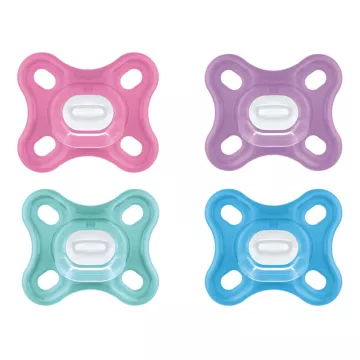
Infant soothers are often recommended for their ability to soothe and calm babies. They stimulate the sucking reflex, which is naturally soothing for young children. They can also reduce the risk of Sudden Infant Death Syndrome (SIDS) when used during sleep. What's more, for infants needing extra comfort between meals or during periods of crying, pacifiers can be an excellent way of providing soothing without resorting to additional feeding.
The choice of a pacifier should be based on several essential criteria: the material of manufacture, the size adapted to the child's age, and the shape of the nipple. Soothers are generally available in silicone or latex, each material having its own advantages. Silicone is durable and easy to clean, while latex is softer but can wear out more quickly. It's crucial to choose a pacifier of the right size for your baby's age, to avoid any risk of suffocation. As for shape, there are orthodontic models designed to preserve the natural development of baby's jaw and gums.
Prolonged use of pacifiers can potentially influence a child's dental development. Studies indicate that frequent use of soothers beyond the age of two or three can lead to dental malformations or changes in jaw structure. It is therefore advisable to limit pacifier use as the child grows, and to consult a paediatric dentist regularly to monitor any potential changes.
To ensure the safety and hygiene of infant soothers, they must be sterilized regularly. Before first use, and periodically thereafter, the pacifier should be immersed in boiling water for five minutes, or used with a suitable sterilizer. It's also important to replace the pacifier every two to three months, or as soon as signs of wear such as cracks or tears appear in the material.
For parents looking for alternatives to traditional soothers, there are options such as teething rings or suction toys specially designed for young children. These alternatives can offer a similar level of comfort, while helping with teething. It's essential to ensure that these products are made from safe, non-toxic materials, and comply with child safety standards.
It is generally considered safe to let a baby fall asleep with a pacifier. Research suggests that the use of pacifiers during sleep may reduce the risk of Sudden Infant Death Syndrome (SIDS). However, it's important to ensure that the pacifier is always clean and in good condition, and that no part of it can come loose to avoid any risk of choking.
Most experts agree that it's best to start using a pacifier after breastfeeding is well established, usually around 3 to 4 weeks after birth. This helps avoid any confusion between breast and pacifier, which could potentially disrupt breastfeeding in some infants.
To help your child stop using a pacifier, start by gradually limiting the time he or she has access to it, especially during the day. Encourage pacifier use only for falling asleep. It's also helpful to positively reinforce pacifier abandonment by celebrating pacifier-free milestones, for example with rewards or special activities.
Prolonged use of pacifiers can be associated with risks such as dental development problems, including malocclusions and palate deformities. It is recommended to reduce or stop pacifier use around the age of two to minimize these risks. Consult a pediatric dentist for personalized advice.
A quality pacifier must be made from safe, non-toxic materials, be free from BPA and phthalates, and comply with current safety standards. It should be orthodontically shaped to promote healthy oral development, and have a shield with ventilation holes to prevent skin irritation. It's also important that it's sturdy, with no detachable parts that could present a choking hazard.